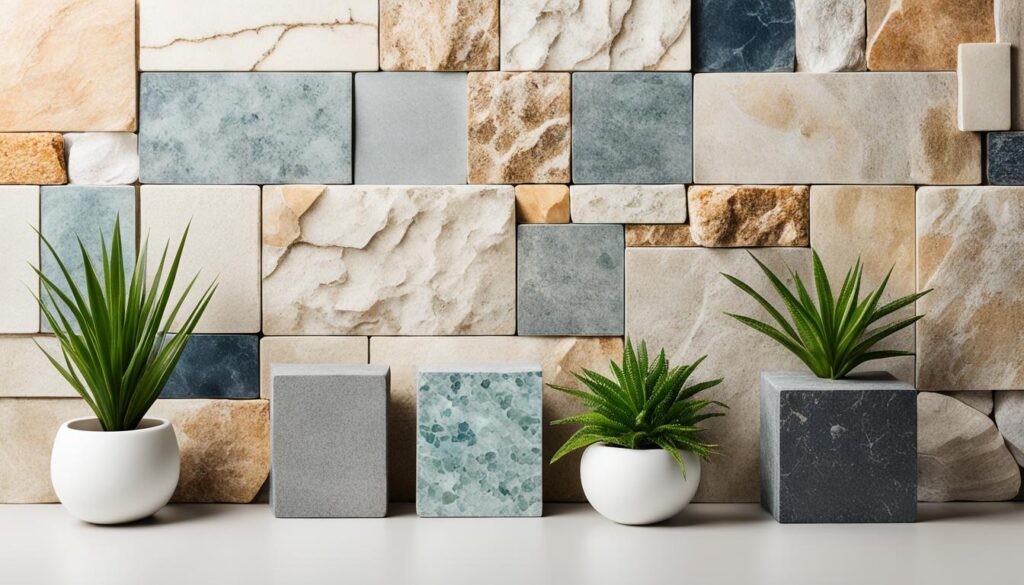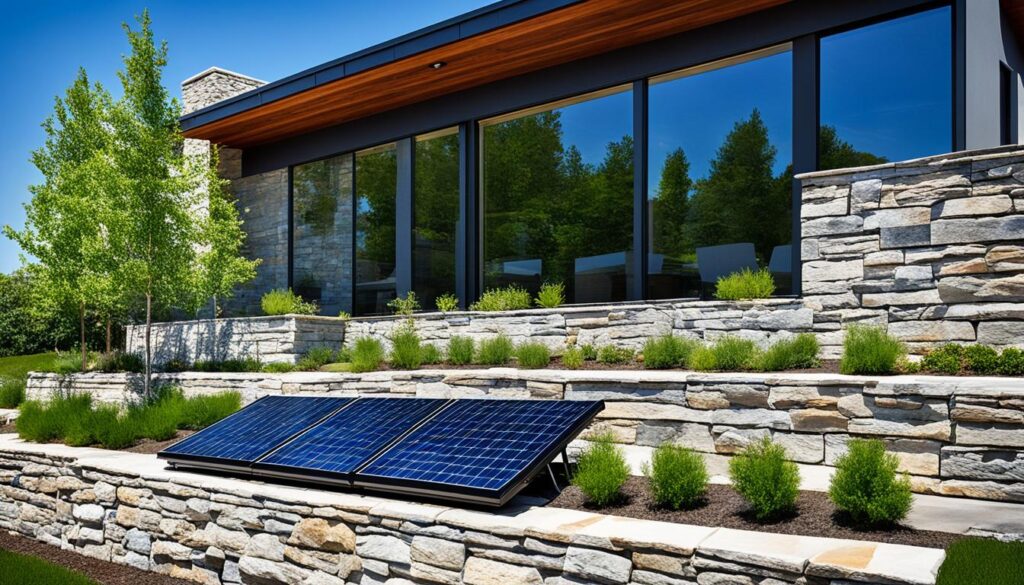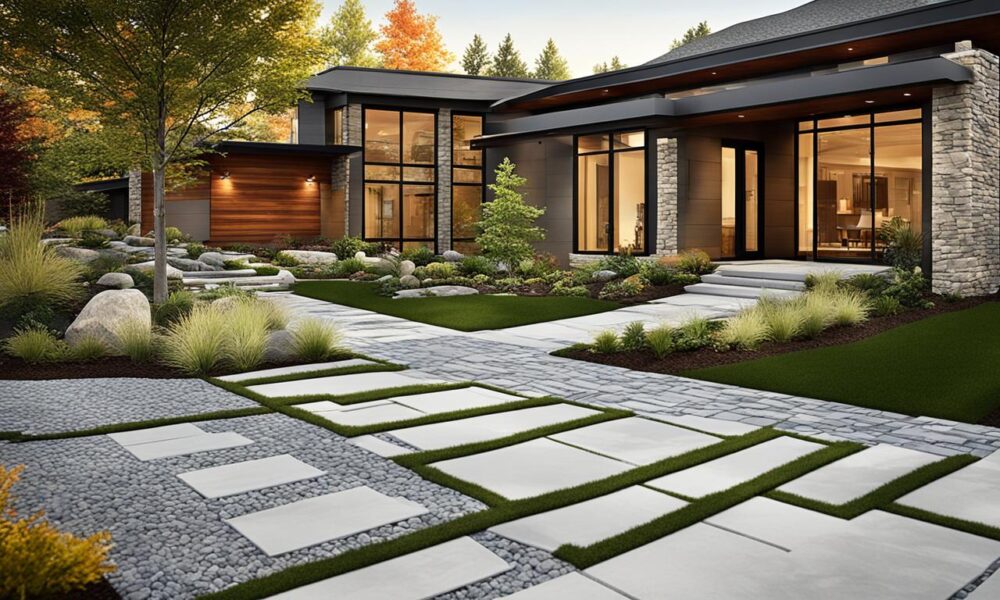Using Natural Stone for Sustainable Home Designs
In the quest for eco-friendly homes, natural stone stands out. It’s chosen for green buildings because it’s tough, has a small environmental impact, and can be recycled. These features make it perfect for projects that cut down on their carbon footprint.
The Natural Stone Council (NSC) plays a key role in making the stone industry more green. They offer advice and examples on how to mine stone in ways that are kind to the environment. Thanks to their efforts, quarries are now being turned into beautiful public spaces after use. And those still working have a plan to restore the land when they’re done.
Natural stone is just right for eco-friendly building. It doesn’t need much extra stuff to be made, which saves resources and cuts down on trash1. Plus, when you’re done with it, stone can be used again, reducing the need for new resources like energy or water1. Unlike wood, stone lasts a really long time and doesn’t need much looking after to stay in good shape1.
You can find many types of natural stone to match your style, from limestone to sandstone1. Using these materials takes less energy than the man-made stuff. This means your project has a smaller environmental impact. Natural stones are also clearly better for the earth than synthetic materials, as they are all-natural2.
The Benefits of Natural Stone in Eco-Friendly Building
Many people now choose natural stone for green home projects. This is because it comes with a lot of eco benefits. Architects and builders mix it into designs to not only look good but to be eco-friendly and last long.
Durability and Longevity of Natural Stone
Natural stone stands out because it’s tough and can take a beating. It shrugs off scratches, chips, and stains, which is perfect for busy parts of the house like kitchens and baths3. With the right care, it can stay looking great for 50 to 100 years. That means less need for updates and more value over time4. This all means it’s a top pick for buildings that want to be kind to the planet. Plus, it uses less new stuff for repairs or changes.
Using natural stone is also easy on the upkeep. Just use some mild soap and water to clean it. And there are stone cleaners that are okay for the environment available too4. This simple care keeps natural stone shining in eco homes for years to come.
Low Environmental Impact of Stone Production
Natural stone doesn’t take much beyond Mother Nature to get it ready for building. With today’s tech, getting it out of the earth and ready for building is more efficient than ever4. Such techs make it better for our wallets and for the planet.
And if you’re building in the U.S. or Canada, chances are you’re not too far from where the stone is from. That’s under 500 miles. It cuts down on how much we pollute when getting the stone to the work site4. Using local stone cuts our carbon footprint even more. So, picking local stone is both good for building and the environment.
| Benefit | Description |
|---|---|
| Durability | Natural stone is resistant to scratches, chips, and stains, ensuring long-lasting performance in high-traffic areas. |
| Longevity | With proper maintenance, natural stone can last for 50 to 100 years, reducing the need for replacements and enhancing home value. |
| Low Environmental Impact | Natural stone requires little to no extra materials for production, and improved quarrying methods minimize waste and conserve resources. |
| Local Availability | Stone quarry sites are often within 500 miles of building sites, reducing greenhouse gas emissions from transportation. |
Natural stone is great not just for building but for the planet too. It’s all recyclable. So, we can find new ways to use it again, instead of using up more of Earth’s resources4. This way, natural stone keeps on giving, making it a top choice for anyone who cares about the environment.
Choosing the Right Natural Stone for Your Sustainable Home
Choosing natural stone for your green home involves looking at many options. There are lots of colors, textures, and features to choose from. This makes it easy to find the right stone for your eco-friendly design2. You can go for the classic beauty of limestone, the rugged look of sandstone, or the timeless charm of granite. Each stone type brings its own unique style and functions well, too.

Variety of Colors, Textures, and Characteristics
Natural stone is very versatile. It comes in various colors, patterns, and finishes. So, it fits well in both modern and traditional designs2. Whether you want a sleek style or a cozy feel, there’s a stone for you. It matches the overall look of your sustainable home perfectly.
When picking a stone, think about how you’ll use it and where. Also, consider how durable, easy to care for, and eco-friendly it is2. By thinking about these things, you can choose a stone that makes your space beautiful. Plus, it will last a long time, which means less waste.
Locally Sourced Stone Options
For a greener home, think about using stone from nearby. Choosing stone that’s made close by cuts down on gas emissions from transportation2. Most places in the U.S. and Canada have quarries not too far away. This makes it easy to find stone that’s local. It also helps meet your eco-goals.
Getting stone from close by doesn’t just help the planet. It also boosts local businesses and jobs2. By using materials from your area, you help your community grow. Plus, your home stands out as a green example.
| Natural Stone Type | Durability | Maintenance | Eco-Friendly Features |
|---|---|---|---|
| Limestone | High | Low | Locally sourced, recyclable25 |
| Sandstone | Medium to High | Low to Medium | Locally sourced, recyclable25 |
| Granite | Very High | Low | Locally sourced, recyclable, long-lasting25 |
| Marble | High | Medium | Locally sourced, recyclable, versatile applications25 |
Picking the right natural stone makes your eco-home look good and do good. Use locally sourced stones with many colors and textures. With the lasting and recyclable nature of these stones, you can have a beautiful home that’s also better for the planet25.
Natural Stone’s Role in Green Building Standards
Natural stone is key in meeting green building standards like LEED. Every day, over 2.2 million square feet are LEED certified6. These efforts help cut down on resource use and lower a building’s negative effects on health and the environment.

Using natural stone in green homes helps earn points for certifications. It’s strong against nature and human damage7. Plus, it’s eco-friendly and doesn’t harm the air we breathe, unlike many other building materials8.
For LEED’s Indoor Environmental Quality (EQ) area, 90% of a part must be low in VOCs6.
Natural stone lasts 50 to 100 years, or even longer. This beats manmade materials, reducing waste and saving resources7.
In the LEED Innovation (IN) category, good project planning earns credit6. Quarrying nearby natural stone helps the local economy and cuts down on emissions8. Shipping it doesn’t use much energy either, making it better for the planet7.
“Natural stone is valued for its durability, aesthetics, and as a natural product that contributes to sustainability goals in architectural projects.”7
LEED buildings are not just good for the planet, they’re good investments. They sell faster and for more money than non-green homes in many places6. A LEED project can be Certified, Silver, Gold, or Platinum6.
Going beyond the minimum can save money in the long run. It ensures green features work well and meets the project’s goals6. Using natural stone, architects and designers make homes that are sustainable and energy-efficient. This cuts down on carbon emissions and supports eco-friendly design6.
Advancements in Sustainable Stone Quarrying Practices
The natural stone industry has stepped up to boost sustainable quarrying practices. These efforts help limit the damage from mining on the environment. Thanks to these improvements, natural stone is now loved for its green benefits. It’s used in energy-saving houses and eco-buildings worldwide.
Quarries now follow strict environmental rules and are checked often by groups like the Mine Safety and Health Administration (MSHA). This is to ensure they’re using the best methods and are reducing their environmental impact.
Compliance with Environmental Guidelines
In today’s world, stone quarries work under clear environmental rules. These rules touch on many areas, like how water is managed, air quality, and even keeping noise down. Quarry workers must follow these rules to keep their licenses. This also helps them avoid fines. This progress in quarrying means stone is now cheaper, greener, and more wanted than before.4
Reclamation Plans for Quarry Sites
Stone quarries are not only focused on their current operations. Many also plan for their sites’ future after mining ends. These reclamation plans are vital. They describe how to turn the land back to nature or make it something good for the community. Beyond 500 miles, stone quarries supply sites for building, supporting local materials and cutting down on harmful gases.4
These steps, along with natural stone’s quality and reusability, make it a top choice. It’s perfect for green homes aiming for a small environmental impact. Stone types like slate, limestone, travertine, and granite last 50 to 100 years, lessening the need for new materials.4 While stone might cost more at first, looking at its entire life cycle, it saves money and hassle compared to other less durable materials.4
Source Links
- https://www.cobrastone.com/3-reasons-why-natural-stone-creates-a-truly-sustainable-home
- https://elementsroom.com/natural-stones-in-sustainable-design/
- https://hamparanstone.com/articles/the-benefits-of-using-natural-stone-in-your-home-durability-aesthetics-and-sustainability/
- https://usenaturalstone.org/top-five-reasons-natural-stone-sustainable-choice-home/
- https://www.signorino.com.au/journal/natural-stone-a-sustainable-solution/
- https://usenaturalstone.org/leed-way-natural-stone/
- https://usenaturalstone.org/natural-stone-mother-natures-original-green-building-material/
- https://www.polycor.com/sustainability/how-stone-is-sustainable/



